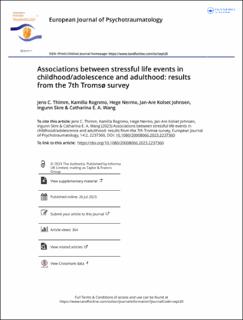Associations between stressful life events in childhood/adolescence and adulthood: results from the 7th Tromsø survey
Thimm, Jens; Rognmo, Kamilla; Nermo, Hege; Johnsen, Jan-Are Kolset; Skre, Ingunn Berta Gjerdåker; Wang, Catharina Elisabeth Arfwedson
Journal article, Peer reviewed
Published version

Åpne
Permanent lenke
https://hdl.handle.net/11250/3098822Utgivelsesdato
2023Metadata
Vis full innførselSamlinger
Originalversjon
European Journal of Psychotraumatology. 2023, 14 (2), 2237360. 10.1080/20008066.2023.2237360Sammendrag
Background:
Exposure to highly stressful life events (SLEs), such as accidents, violence, or serious illness, is common. With the accumulation of SLEs, the risk of detrimental somatic and mental health outcomes increases. To understand patterns of SLE exposure, research into the associations between SLEs is needed.
Method:
The sample comprised 21,069 participants of the population-based Tromsø7 (2015/2016) study (52.7% female, mean age = 57.3 years, SD = 11.4 years). Participants were asked whether they had experienced eleven SLEs in childhood/adolescence and adulthood. Correlations, network analysis, and logistic regression analysis were used to examine the associations between SLEs.
Results:
Medium-sized to large correlations between SLEs in childhood/adolescence and SLEs in adulthood were found. Two clusters of SLEs emerged in the network analysis in childhood/adolescence and in adulthood, respectively, interpreted as interpersonal (e.g. violence and sexual abuse) and impersonal SLEs (e.g. a life-threatening illness or serious accident). SLEs in childhood/adolescence predicted the number of SLEs in adulthood as well as exposure to the specific SLE categories in adulthood. Childhood neglect was an important predictor of SLE exposure in adulthood.
Conclusions:
Public health policies should focus on the prevention of SLEs and the early intervention after SLE exposure, especially childhood neglect.
